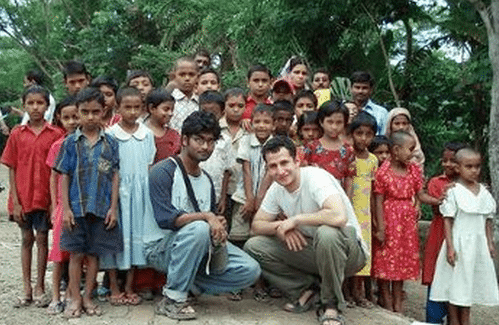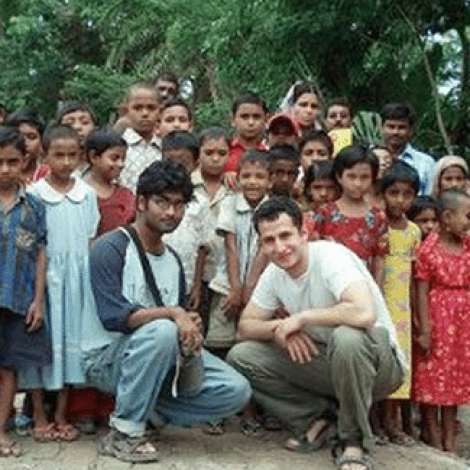 Josh Sperling (front-right) poses with Imrul Kayes, co-founder of Architecture for Humanity-Dhaka (front left) and Bangladeshi school children who were affected by Cyclone Sidr, which caused heavy damage in Bangladesh on Nov. 17, 2007. Photo courtesy of Josh Sperling
Josh Sperling (front-right) poses with Imrul Kayes, co-founder of Architecture for Humanity-Dhaka (front left) and Bangladeshi school children who were affected by Cyclone Sidr, which caused heavy damage in Bangladesh on Nov. 17, 2007. Photo courtesy of Josh Sperling
Rather than putting his faith in a cure-all solution for global development, Josh Sperling values diversity. He looks to a diversity of specialties to find lasting solutions. Accordingly, his resume is long and could be confused for a guide to global development organizations that build things. Some of those include BRAC, ARUP Poverty Action Network, Water for People, a half-dozen chapters of Engineers Without Borders and others, and he has invitations to the UN World Water Organization, the World Energy Forum, the International Youth Assembly and others.
With his deep blend of academic and real-world development engineering experience, Sperling has a uniquely informed view on sustainable urban planning and infrastructure. He is pursuing a doctorate in sustainable urban infrastructure at the University of Colorado, Denver, a program that encompasses the fields of engineering, planning, policy, health and behavioral sciences. He is planning the opening of a new US chapter of RedR-International, and he was worked with Engineers Without Borders chapters in India, Bangladesh, Chile, the University of Colorado, New York, and he helped launch the new EWB-USA NYU: Polytechnic University Chapter.
We asked Josh Sperling five questions.
How do you explain your work and field of study when you’re asked?
My work as a multidisciplinary engineer and strategic planner typically focuses on the environment, infrastructure, and local sustainable development solutions that integrate people, nature, and communities. My field of study is at the nexus of infrastructure systems, public health, and climate change (mainly at city and community scales).
What is one thing that people either don’t know, or don’t understand about sustainability in urban development?
Reimagining and reinventing our urban infrastructure systems, behaviors, and policies are all essential for achieving scalable pathways toward sustainable urban development globally. By urban infrastructure, we refer to the natural and engineered systems that provide water, energy, transport, sanitation, information, recreation, health, and built environment services for more than half of the world’s population. At the same time, and as relevant to the E4C initiative, it is important to realize that change, no matter how desirable, is not simple. Practical insights, passion, compassion, patience, effective measurement tools, benchmarking and strategic thinking are all required.
What is one of the promising trends that you see in infrastructure and urban planning today?
One promising trend I am excited about is the increased use of participatory and interdisciplinary, evidence-based approaches. Early linkage of multiple disciplines, skills, and diverse stakeholders for local and inclusive decision-making can be critical in avoiding and responding to past and current societal failures. Examples of this are the education, research and community engagement models developed through the University of Colorado, Denver campus, Sustainable Urban Infrastructure program and the multifaceted approaches addressing infrastructure, health, education, micro-finance, and empowerment of women conducted by BRAC in Bangladesh and globally.
What do you think is a dead end in your field that some people just won’t let die?
I think the pursuit of “top-down” and “silver-bullet” solutions can often be a dead end. The global problems the engineering community faces must be addressed in a multifaceted and interdisciplinary manner, while recognizing the complex nature of problems, local challenges, and language and cultural differences.
Five years from now, what improvements would you like to see in the technology you use?
Five years from now, I’ll be excited to see ongoing innovation and adoption of cell phone technology, specifically for GIS mapping, short video blogs, and empowerment of women. In addition, technologies that can serve the purposes of evaluation and monitoring, while also holding us accountable to both successes and failures in our work towards long-term improvements for health and well-being will be critical.

